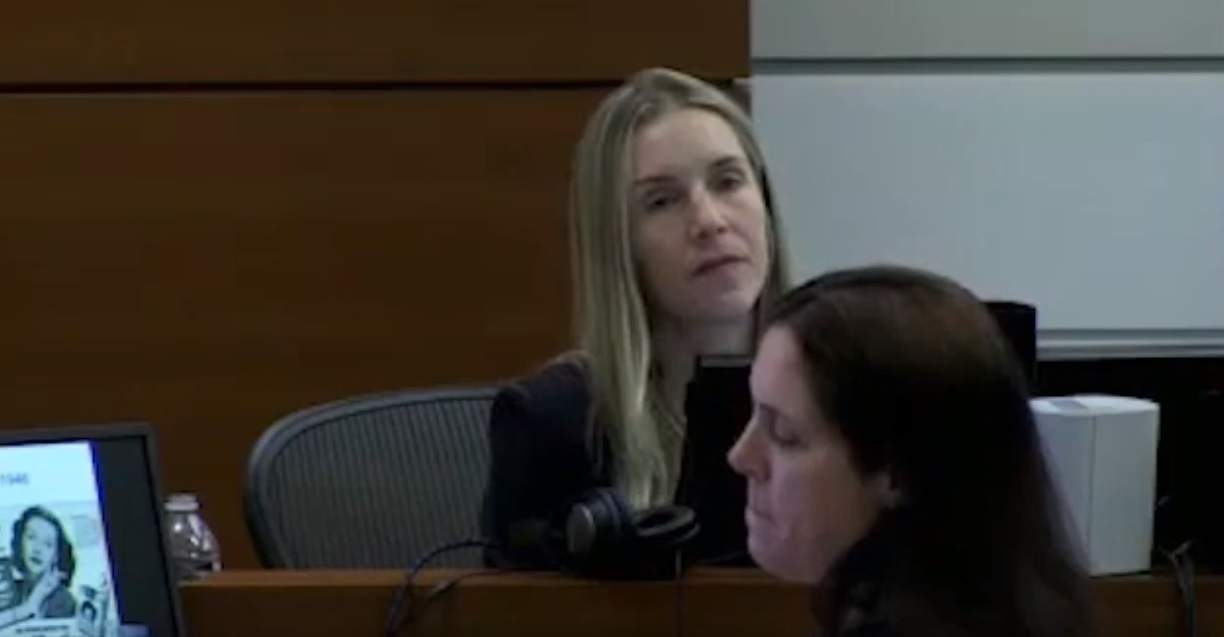

The Expert: Judith Prochaska, a psychologist and Stanford professor, on the link between nicotine addiction and disease, as well as evidence of addiction the smoker at the heart of the trial bore.

Dr. Judith Prochaska, a clinical psychologist from Stanford shown here in a 2019 Florida tobacco trial, testifies regarding the link between nicotine addiction and lung cancer, and how this addiction was manifest in the lung cancer victim in this case.
The testimony begins by establishing that smoking tobacco causes addiction and disease that leads to death. It is the nicotine that is mixed with the tobacco by the cigarette manufacturers, that actually causes the addiction. Without the nicotine, early users “would not get hooked as kids” and long-term users would not be compelled to continue smoking. The doctor cautions that the use of terms like “light and ultra-light” do not really mean that there is less nicotine, but when cigarettes that are truly lower in nicotine are studied, they have been found to be less addictive and easier to forego.
Prochaska compares the plaintiff’s addictive smoking pattern to that of a social smoker. Given that tobacco is a carcinogen, this demonstrates how often she was exposed to the carcinogen throughout her life. The smoker was considered to be a “chainsmoker” by the number of cigarettes smoked, lighting one from another. By calculating the number of cigarettes in three packs smoked per day, multiplying that by the number of days in a year, multiplying that by the number of years smoked and that by ten puffs per cigarette, the expert calculates 13 million doses of nicotine and concomitant tobacco exposure with its carbon monoxide and multiple carcinogens. She testifies that, in this patient, nicotine addiction was the fundamental reason that she continued smoking for almost 60 years. Her addiction therefore was the main reason for her continuous exposure to the cancer-causing components of tobacco, her subsequent development of lung cancer, and her ultimate demise.
The expert then examines the marketing tools utilized by the cigarette companies during the smoker’s lifetime and how that influenced her behavior. This woman smoked a brand that offered a coupon with each pack of cigarettes and four extra coupons if a carton was purchased. These coupons could be traded in for household items. This encouraged this patient to buy cartons of cigarettes. From the users’ standpoint, this made introverted, family-oriented people feel a part of something bigger and, since they tended to have less money, it promoted the free household items as an excuse to smoke. In this case, she collected the coupons and traded them in for a child’s rocking chair.
The influential advertisements that were offered as evidence included scenes with famous women of the time, romantic scenes, happy and relaxing themes, claims of the product being “natural,” and therefore implying that it can’t be bad for you. Names used in marketing connoted “beautiful air” and showed fluffy white clouds, not the dirty clouds of smoking. The product used by this client advertised that it had less nicotine and was therefore less irritating to the throat. This would be true, but that is far less important that admitting that this product was addictive.
The deceased smokerin this case was influenced by these marketing techniques, the expert says, and beginning at age 14 she would start showing signs of addiction. She experienced sustained use over 57 years despite attempts to quit, and engaged in typical behavior of addicted smokers, such as smoking in bed, interrupting her sleep to smoke, and prioritizing the purchase of cigarettes over food or paying bills. Her fingers were stained yellow from smoking the cigarette down to the end of the butt, and she would frequently relight butts from the ashtray, argue with family members about smoking, have to leave during important events to smoke, avoid places that would not allow smoking, interrupt movies to smoke, and continued to smoke despite her diagnosis of lung cancer. She had a drive to use, without medical purpose, despite the known consequences of that use. All of this, the expert concludes, is indicative of a severe addiction.
The jury agreed, concluding her addiction kept her smoking and led to her demise. They awarded $10 million.
Gary Gansar, MD, is residency-trained in general surgery. He served as Chief of Surgery and Staff at Elmwood Medical Center and on the Medical Executive Committee at Touro Infirmary and Mercy Hospital in New Orleans, LA. Dr. Gansar was Board Certified in general surgery while in active practice. He joined AMFS in 2015 as a Physician Medical Director.
The medical expert witness partner for attorneys serious about building a winning case
AMFS is your trusted source for highly-qualified medical expert witnesses. After pioneering the field nearly three decades ago, we’re continuing to redefine medical expert witness services by providing value far beyond a referral alone.
Our Physician Medical Directors know what it takes to build a strong case. Our medical expert witnesses leave no doubt. And our case managers streamline billing and logistics every step of the way, letting you focus on what you do best: constructing your winning case. Explore why AMFS clients expect more from their medical expert witnesses—and get it.
